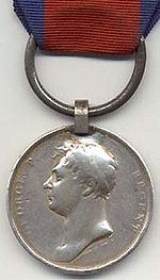
Waterloo Medal
Encyclopedia
The Waterloo Medal was awarded to any soldier of the British Army
who took part in one or more of the following battles: Battle of Ligny
(16 June 1815), Battle of Quatre Bras
(16 June 1815), and the Battle of Waterloo
(18 June 1815).
The medal was issued in 1816–17 to every soldier present at one or more of these battles. They were also credited with two extra years service, to count for all purposes. The obverse of this medal bears the effigy of the Prince Regent
with the inscription 'GEORGE P. REGENT', while the reverse depicts the seated figure of Victory with the words 'WELLINGTON' and 'WATERLOO' below and the date 'JUNE 15 1815'. The ribbon passes through a large iron ring on top of the medal. The medal is made of silver and is 37mm wide. A total of 39,000 were awarded.
This is the first medal issued by the British Government to all soldiers present at an action. The Military General Service Medal
(MGSM) commemorates earlier battles, but was not issued until 1848. The Waterloo Medal was also the first campaign medal awarded to the next-of-kin of men killed in action.
It was also the first medal on which the recipient's name was impressed around the edge by machine.
British Army
The British Army is the land warfare branch of Her Majesty's Armed Forces in the United Kingdom. It came into being with the unification of the Kingdom of England and Scotland into the Kingdom of Great Britain in 1707. The new British Army incorporated Regiments that had already existed in England...
who took part in one or more of the following battles: Battle of Ligny
Battle of Ligny
The Battle of Ligny was the last victory of the military career of Napoleon I. In this battle, French troops of the Armée du Nord under Napoleon's command, defeated a Prussian army under Field Marshal Blücher, near Ligny in present-day Belgium. The bulk of the Prussian army survived, however, and...
(16 June 1815), Battle of Quatre Bras
Battle of Quatre Bras
The Battle of Quatre Bras, between Wellington's Anglo-Dutch army and the left wing of the Armée du Nord under Marshal Michel Ney, was fought near the strategic crossroads of Quatre Bras on 16 June 1815.- Prelude :...
(16 June 1815), and the Battle of Waterloo
Battle of Waterloo
The Battle of Waterloo was fought on Sunday 18 June 1815 near Waterloo in present-day Belgium, then part of the United Kingdom of the Netherlands...
(18 June 1815).
The medal was issued in 1816–17 to every soldier present at one or more of these battles. They were also credited with two extra years service, to count for all purposes. The obverse of this medal bears the effigy of the Prince Regent
George IV of the United Kingdom
George IV was the King of the United Kingdom of Great Britain and Ireland and also of Hanover from the death of his father, George III, on 29 January 1820 until his own death ten years later...
with the inscription 'GEORGE P. REGENT', while the reverse depicts the seated figure of Victory with the words 'WELLINGTON' and 'WATERLOO' below and the date 'JUNE 15 1815'. The ribbon passes through a large iron ring on top of the medal. The medal is made of silver and is 37mm wide. A total of 39,000 were awarded.
This is the first medal issued by the British Government to all soldiers present at an action. The Military General Service Medal
Military General Service Medal
The Military General Service Medal was a campaign medal approved in 1847, for issue to officers and men of the British Army.The MGSM was approved on 1 June 1847 as a retrospective award for various military actions from 1793–1814; a period encompassing the French Revolutionary Wars, the Napoleonic...
(MGSM) commemorates earlier battles, but was not issued until 1848. The Waterloo Medal was also the first campaign medal awarded to the next-of-kin of men killed in action.
It was also the first medal on which the recipient's name was impressed around the edge by machine.

